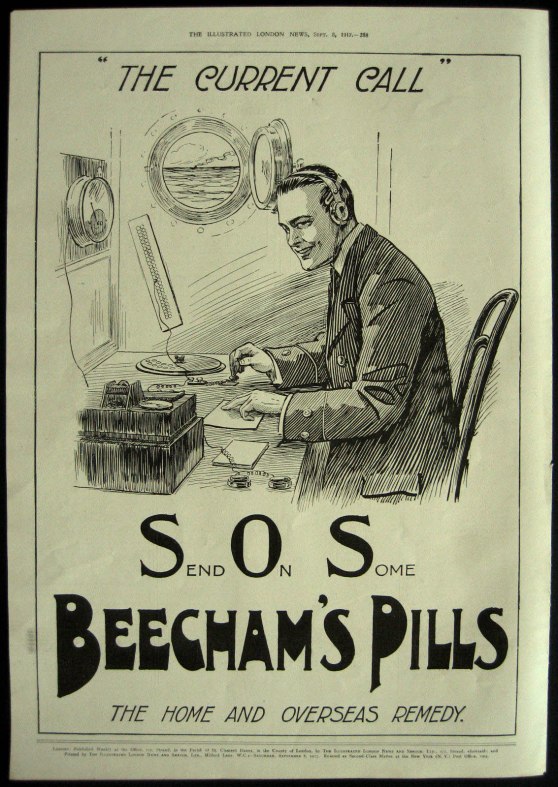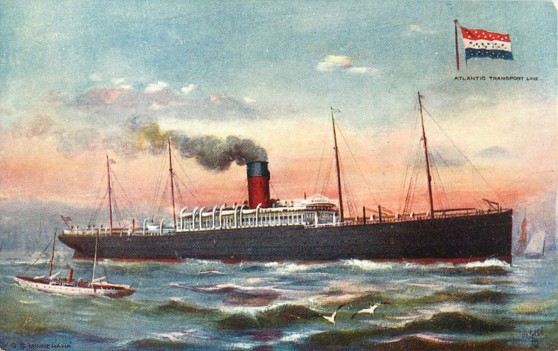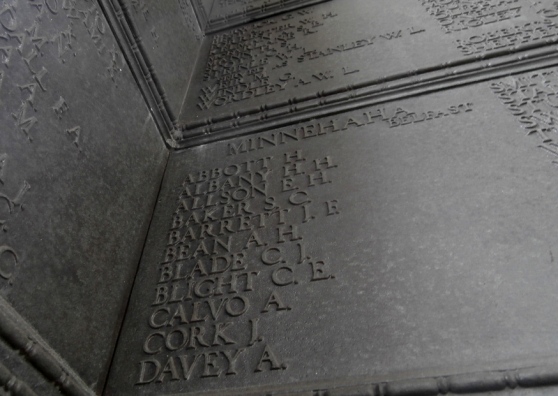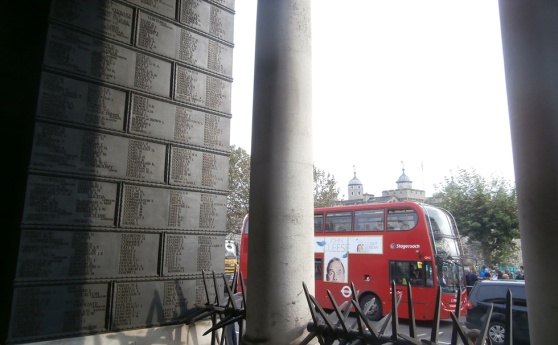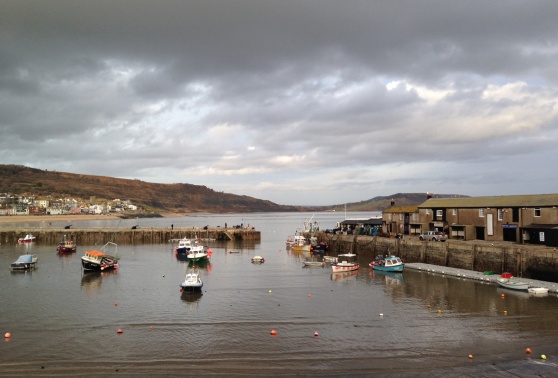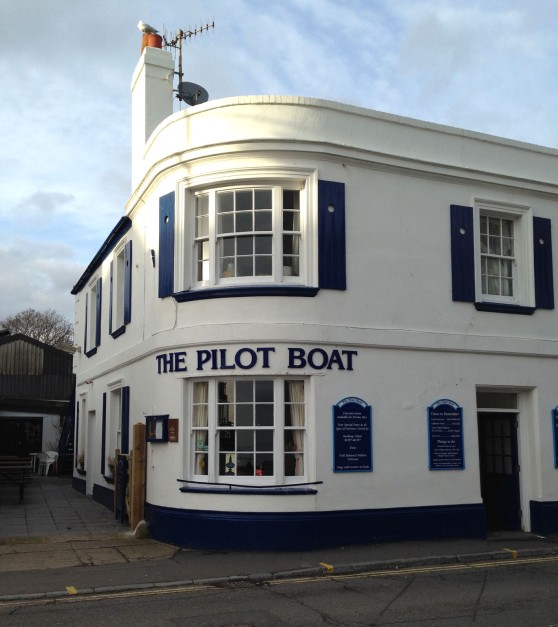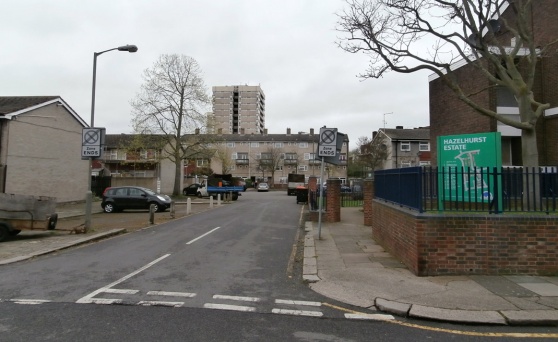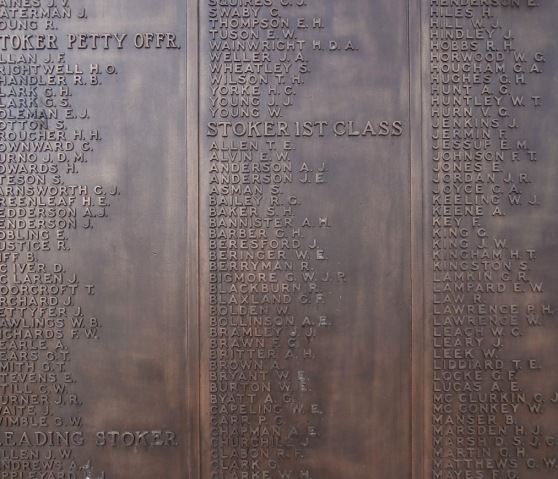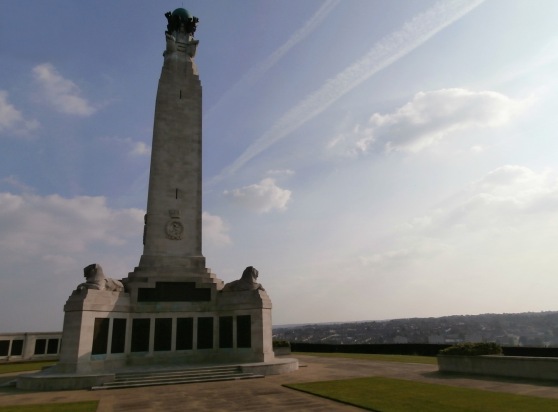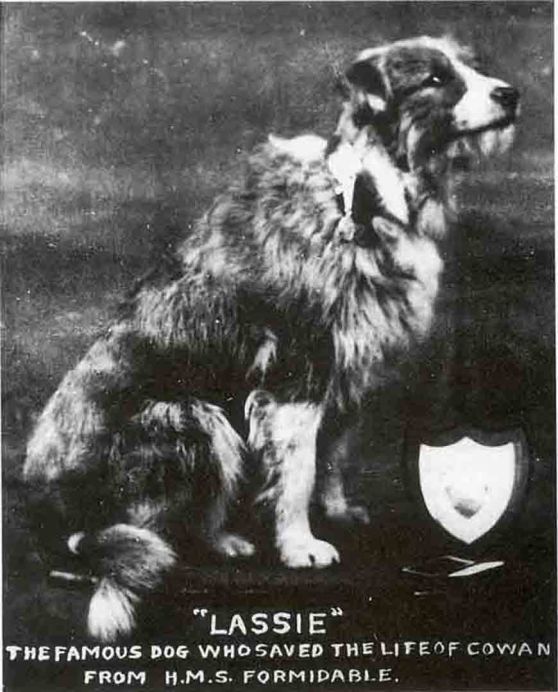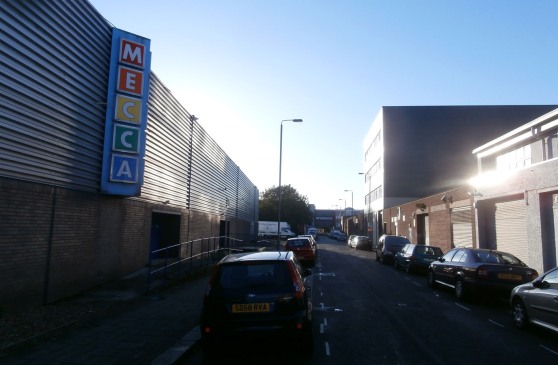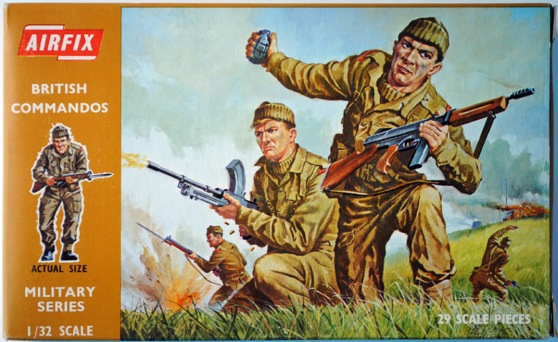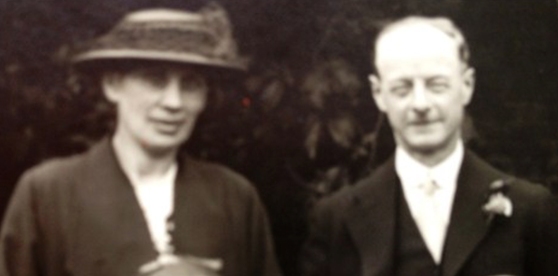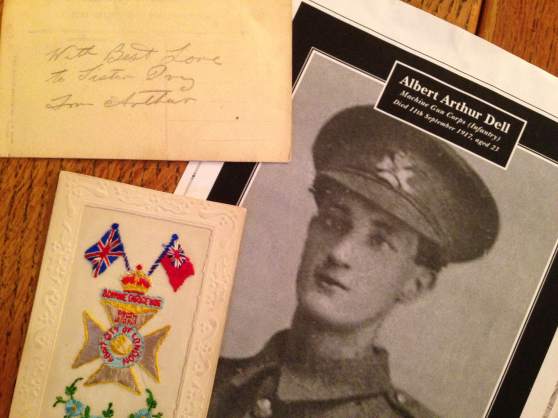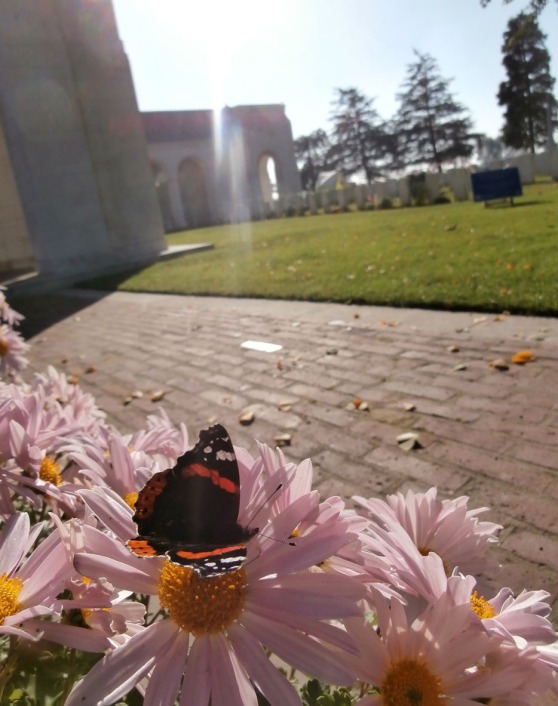
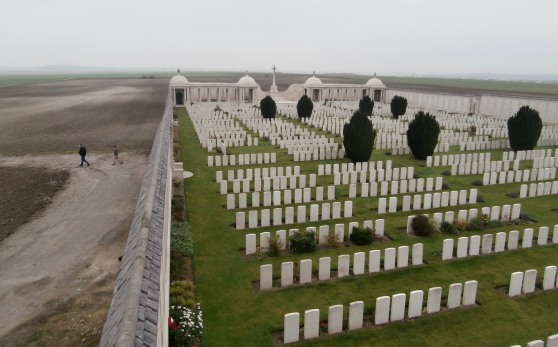
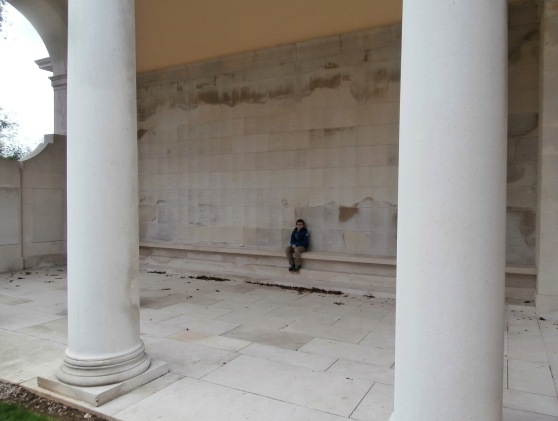 A year on from first becoming aware of the Sunday School Three and the incredible story of the emergence of their memorial tablet from a pile of compost in the rectory garden, it was time to make a visit to their final resting places. They were all killed in three terrible battles and none of their bodies were ever recovered, consequently their names have been engraved on memorials to ‘those with no known grave’. These are in a corner of northern France, not far from the Belgian border and no more than 25 miles apart. William Mace’s name is on the Le Touret Memorial near the town of Bethune. James Crozier is on the Loos Memorial just outside Lens. Albert Gibson is one of 35,000 names on the enormous Arras Memorial. We travelled to France and Belgium earlier this week to visit these memorials and other cemeteries where we know members of the Summerstown182 rest. It was a hectic schedule but we were blessed with fine weather and the expert guidance of Bart Seynaeve from Gullegem. In the space of three days we saw a total of 39 of our 182 names carved into the white stone, either on a headstone or a memorial.
A year on from first becoming aware of the Sunday School Three and the incredible story of the emergence of their memorial tablet from a pile of compost in the rectory garden, it was time to make a visit to their final resting places. They were all killed in three terrible battles and none of their bodies were ever recovered, consequently their names have been engraved on memorials to ‘those with no known grave’. These are in a corner of northern France, not far from the Belgian border and no more than 25 miles apart. William Mace’s name is on the Le Touret Memorial near the town of Bethune. James Crozier is on the Loos Memorial just outside Lens. Albert Gibson is one of 35,000 names on the enormous Arras Memorial. We travelled to France and Belgium earlier this week to visit these memorials and other cemeteries where we know members of the Summerstown182 rest. It was a hectic schedule but we were blessed with fine weather and the expert guidance of Bart Seynaeve from Gullegem. In the space of three days we saw a total of 39 of our 182 names carved into the white stone, either on a headstone or a memorial. 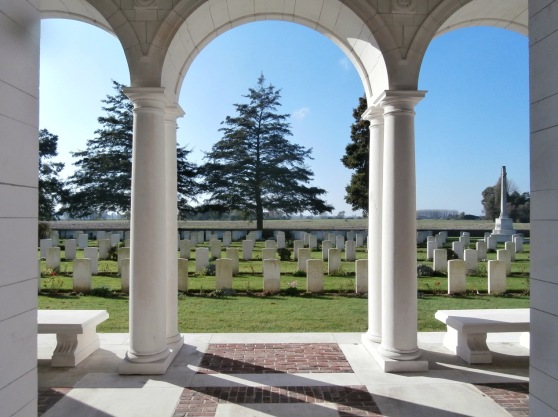 Le Touret was difficult to find, on the edge of Bethune close to a spot where our Great Uncle lost half a finger in an unfortunate skirmish in a trench with one of his own men. Willam Mace died in the Batte of Festubert which over four or five days at the end of May 1915 claimed the lives of 12,000 British soldiers. It was also famously where the British Army ran out of shells, hard to imagine considering the never-ending stream of them seemingly popping out of the ground today. It was a sobering thought to imagine this place was the last stand of that long list of names in the South Western Star newspaper. The 23rd London Regiment’s ‘Gallant Charge’ and the end of the road for so many young men from south-west London. The countryside of course now radiates tranquility but the memorial itself was a hive of frenetic noise and activity. Restoration and sprucing-up was in full swing and at least a dozen workmen were hard at it. I felt sorry for them, they are doing great work but anyone visiting the cemetery for quiet reflection was in for a surprise. The idyllic and peaceful nature of Huntspill Street and the whitewashed home of William Mace at No39 may conjure up a vision of a Greek island, but the Le Touret Memorial with its arches and colonnades is more like a Roman temple. In the central courtyard of this elegant structure we found our man quite easily and his panel was literally dazzling in the lunchtime sunshine. Keeping him company are three other Summerstowners; George Boast, Cecil Passingham and Robert Lake. To cap it all, a pair of beautiful Red Admiral butterflies dutifully posed for us on some pink daisies at the cemetery entrance as we made our way out.
Le Touret was difficult to find, on the edge of Bethune close to a spot where our Great Uncle lost half a finger in an unfortunate skirmish in a trench with one of his own men. Willam Mace died in the Batte of Festubert which over four or five days at the end of May 1915 claimed the lives of 12,000 British soldiers. It was also famously where the British Army ran out of shells, hard to imagine considering the never-ending stream of them seemingly popping out of the ground today. It was a sobering thought to imagine this place was the last stand of that long list of names in the South Western Star newspaper. The 23rd London Regiment’s ‘Gallant Charge’ and the end of the road for so many young men from south-west London. The countryside of course now radiates tranquility but the memorial itself was a hive of frenetic noise and activity. Restoration and sprucing-up was in full swing and at least a dozen workmen were hard at it. I felt sorry for them, they are doing great work but anyone visiting the cemetery for quiet reflection was in for a surprise. The idyllic and peaceful nature of Huntspill Street and the whitewashed home of William Mace at No39 may conjure up a vision of a Greek island, but the Le Touret Memorial with its arches and colonnades is more like a Roman temple. In the central courtyard of this elegant structure we found our man quite easily and his panel was literally dazzling in the lunchtime sunshine. Keeping him company are three other Summerstowners; George Boast, Cecil Passingham and Robert Lake. To cap it all, a pair of beautiful Red Admiral butterflies dutifully posed for us on some pink daisies at the cemetery entrance as we made our way out.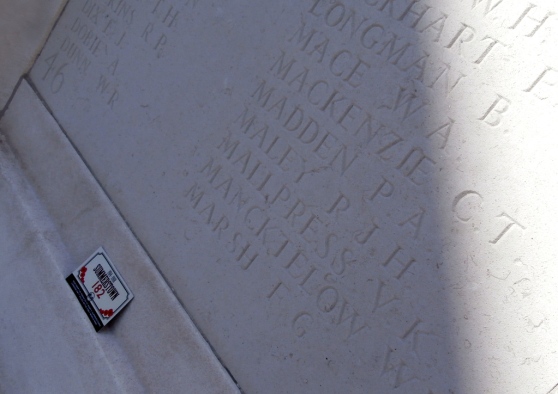
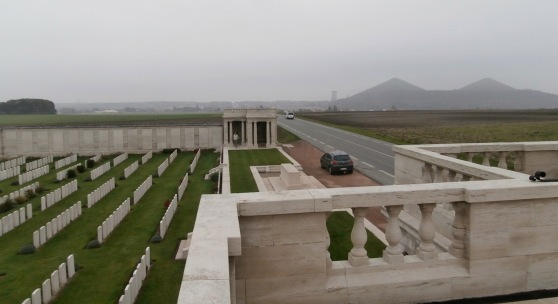 The following day, the mist hung heavy and the temperature dropped by about ten degrees. It suited the mood. With Bart at the wheel and his SatNav firing on all cylinders, the graveyards came thick and fast. The Loos Memorial emerged very swiftly out of the mess of ring-roads and industrial units on the perimeter of Lens. Suddenly the ground was pancake flat with the striking exception of a number of pyramid-like slagheaps – a testimony to this area’s mining heritage and a reason why the fighting around here was so difficult. This was the dreadful place where two civilised nations decided it was a good idea to fire poison gas bombs at each other. It was cold and bleak, the landscape almost lunar. The walled memorial with its 20,000 names was like a fortress surrounded by endless acres of cultivated farmland. Bart went for a wander and spotted a couple of rusted hand grenades which had recently been churned up and presumably tossed aside by a farmer. The area was once known as Dud Corner for the amount of unexploded devices found here at the end of the conflict. Once again we found who we were looking for quite quickly. James Jenner Crozier from Smallwood Road has his back to the twin spoil heaps knows as ‘Pits 11 and 19’ and recently classified as a UNESCO World Heritage Site. His companions here, William Copeman and Percy Randall are on different sides of the memorial so they can all keep an eye on each other. But certainly on this greyest of days, beneath the most leaden of skies they could have done with some Summerstown daffodils to brighten things up.
The following day, the mist hung heavy and the temperature dropped by about ten degrees. It suited the mood. With Bart at the wheel and his SatNav firing on all cylinders, the graveyards came thick and fast. The Loos Memorial emerged very swiftly out of the mess of ring-roads and industrial units on the perimeter of Lens. Suddenly the ground was pancake flat with the striking exception of a number of pyramid-like slagheaps – a testimony to this area’s mining heritage and a reason why the fighting around here was so difficult. This was the dreadful place where two civilised nations decided it was a good idea to fire poison gas bombs at each other. It was cold and bleak, the landscape almost lunar. The walled memorial with its 20,000 names was like a fortress surrounded by endless acres of cultivated farmland. Bart went for a wander and spotted a couple of rusted hand grenades which had recently been churned up and presumably tossed aside by a farmer. The area was once known as Dud Corner for the amount of unexploded devices found here at the end of the conflict. Once again we found who we were looking for quite quickly. James Jenner Crozier from Smallwood Road has his back to the twin spoil heaps knows as ‘Pits 11 and 19’ and recently classified as a UNESCO World Heritage Site. His companions here, William Copeman and Percy Randall are on different sides of the memorial so they can all keep an eye on each other. But certainly on this greyest of days, beneath the most leaden of skies they could have done with some Summerstown daffodils to brighten things up. 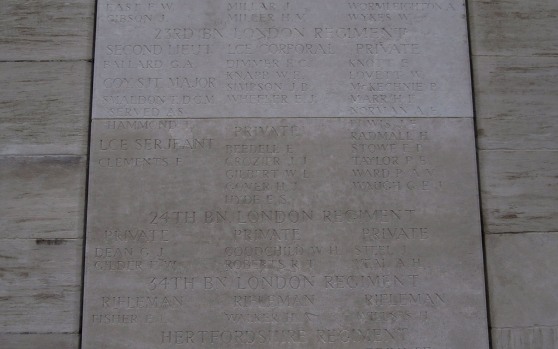 Arras is only about ten miles south of here and the vast Arras Memorial is fairly close to the centre of the town. There are eleven members of the Summerstown182 remembered here and one of these was the third Sunday School teacher, Albert Laurence Gibson. There was more drilling and tarmacing to deal with, but this time it was the dual carriageway outside the cemetery. On this enormous sprawling edifice designed by Lutyens, are the names of over 35,000 men killed in the Arras sector between 1916 and 1918 but largely the Battle of Arras in the spring of 1917. Lance Corporal Albert Gibson from Waldron Road lost his life a little later in the fighting at Cambrai in December 1917. With its columns, arches and walkways, it also has a Roman feel but perhaps starting to decline. Some of the names are barely readable, the stone is dis-colouring in places and its going to need a bit of attention soon. We found that splashing a little water on some of the worn-away names aided legibility. Albert Gibson was tucked away on the western side of the memorial and didn’t need any dowsing. Not too far away from him Pete came across a little wooden poppy cross bearing a tribute to Sandy Turnbull, the man who scored the winning goal for Manchester United in the 1909 FA Cup Final. He was killed on 3rd May 1917, the same day as William Pitts from Hazelhurst Road whose engraved name we also found. Also killed on that day and in the same Bay Six as Sandy Turnbull is Christine’s relative, Charles Sharples from Fairlight Road. He somehow evaded the St Mary’s Church war memorial but not our camera.
Arras is only about ten miles south of here and the vast Arras Memorial is fairly close to the centre of the town. There are eleven members of the Summerstown182 remembered here and one of these was the third Sunday School teacher, Albert Laurence Gibson. There was more drilling and tarmacing to deal with, but this time it was the dual carriageway outside the cemetery. On this enormous sprawling edifice designed by Lutyens, are the names of over 35,000 men killed in the Arras sector between 1916 and 1918 but largely the Battle of Arras in the spring of 1917. Lance Corporal Albert Gibson from Waldron Road lost his life a little later in the fighting at Cambrai in December 1917. With its columns, arches and walkways, it also has a Roman feel but perhaps starting to decline. Some of the names are barely readable, the stone is dis-colouring in places and its going to need a bit of attention soon. We found that splashing a little water on some of the worn-away names aided legibility. Albert Gibson was tucked away on the western side of the memorial and didn’t need any dowsing. Not too far away from him Pete came across a little wooden poppy cross bearing a tribute to Sandy Turnbull, the man who scored the winning goal for Manchester United in the 1909 FA Cup Final. He was killed on 3rd May 1917, the same day as William Pitts from Hazelhurst Road whose engraved name we also found. Also killed on that day and in the same Bay Six as Sandy Turnbull is Christine’s relative, Charles Sharples from Fairlight Road. He somehow evaded the St Mary’s Church war memorial but not our camera. 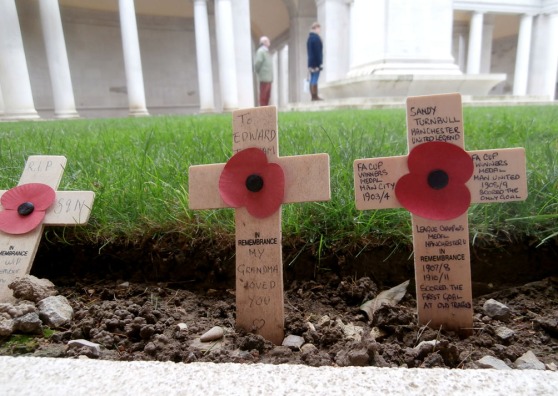
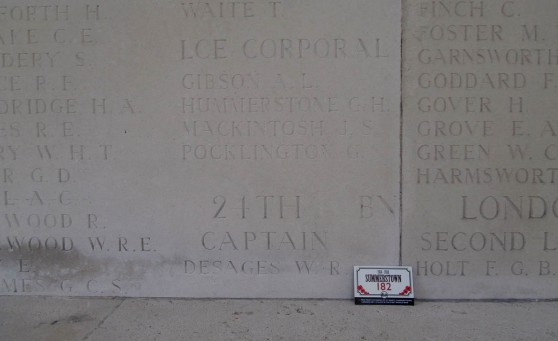 These are exciting times for the Sunday School Three. Not only have they all been visited in the green fields of France, but their tablet has been cleaned up and will be present in church on Remembrance Sunday. This promises to be a remarkable occasion when the names on the war memorial will be read out in full for probably the first time since it was inaugurated in 1919. If you would like to read the full story about the Sunday School Three and their special memorial, please see the link in the main menu.
These are exciting times for the Sunday School Three. Not only have they all been visited in the green fields of France, but their tablet has been cleaned up and will be present in church on Remembrance Sunday. This promises to be a remarkable occasion when the names on the war memorial will be read out in full for probably the first time since it was inaugurated in 1919. If you would like to read the full story about the Sunday School Three and their special memorial, please see the link in the main menu.

